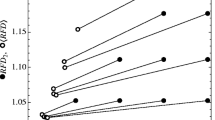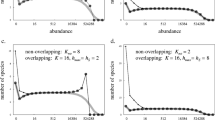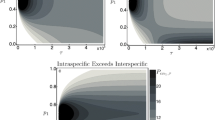Abstract
Debate remains on the contributions of niche and neutral processes in structuring biological communities. Temporal variation in the extent to which these two processes may jointly operate makes the problem of resolving their roles even more daunting. Here, we gain insight into this problem by using deterministic and stochastic models of competitors to investigate how the occurrence of rare niches, in what is usually a neutrally structured community, affects species diversity. Rare niches are modeled by allowing each species access to unique resources, which occur with temporal variability. While results from the deterministic model are clear (rare niches provide stable coexistence to otherwise neutral competitors), demographic stochasticity complicates this picture. Stochastic rare niche models show parameter regimes where increases in rare niches actually increase extinction risk by amplifying the variance in population counts. We also use our stochastic model to evaluate the effectiveness of current empirical methods in resolving the difference between rare niche and neutral systems. We find that in many cases, stochastic variation makes niche and neutral systems indistinguishable, allowing for the possibility of niche systems to masquerade as neutral ones. These results highlight the need to better understand how demographic stochasticity and environmental variation can affect the maintenance of species diversity.





Similar content being viewed by others
References
Ackerly DD, Cornwell WK (2007) A trait-based approach to community assembly: partitioning of species trait values into within- and among-community components. Ecol Lett 10:135–145
Adler PB, Drake JM (2008) Environmental variation, stochastic extinction, and competitive coexistence. Am Nat 172:186–195. doi:10.1086/591678
Adler PB, Fajardo A, Kleinhesselink AR, Kraft NJ (2013) Trait-based tests of coexistence mechanisms. Ecol Lett 16:1294–1306
Adler PB, HilleRisLambers J, Kyriakidis PC et al (2006) Climate variability has a stabilizing effect on the coexistence of prairie grasses. Proc Natl Acad Sci 103:12793–12798
Adler PB, HilleRisLambers J, Levine JM (2007) A niche for neutrality. Ecol Lett 10:95–104. doi:10.1111/j.1461-0248.2006.00996.x
Angert AL, Horst JL, Huxman TE, Venable DL (2010) Phenotypic plasticity and precipitation response in Sonoran Desert winter annuals. Am J Bot 97:405–411. doi:10.3732/ajb.0900242
Angert AL, Huxman TE, Chesson P, Venable DL (2009) Functional tradeoffs determine species coexistence via the storage effect. Proc Natl Acad Sci 106:11641–11645
Ashton IW, Miller AE, Bowman WD, Suding KN (2010) Niche complementarity due to plasticity in resource use: plant partitioning of chemical N forms. Ecology 91:3252–3260
Bell G (2001) Neutral macroecology. Science 293:2413–2418
Black AJ, McKane AJ (2012) Stochastic formulation of ecological models and their applications. Trends Ecol Evol 27:337–345
Cáceres CE (1997) Temporal variation, dormancy, and coexistence: a field test of the storage effect. Proc Natl Acad Sci 94:9171–9175
Callaway RM, Pennings SC, Richards CL (2003) Phenotypic plasticity and interactions among plants. Ecology 84:1115–1128
Chesson P (2003) Quantifying and testing coexistence mechanisms arising from recruitment fluctuations. Theor Popul Biol 64:345–357
Chesson P (1991) A need for niches? Trends Ecol Evol 6:26–28. doi:10.1016/0169-5347(91)90144-M
Chesson P (2000a) Mechanisms of maintenance of species diversity. Annu Rev Ecol Syst 31:343–366
Chesson P (2000b) General theory of competitive coexistence in spatially-varying environments. Theor Popul Biol 58:211–237
Chesson P (1994) Multispecies competition in variable environments. Theor Popul Biol 45:227–276
Chesson P (2008) Quantifying and testing species coexistence mechanisms. Unity Divers. Reflect. Ecol. Leg. Ramon Margalef. Fundación BBVA, pp 119–164
Chesson P, Huntly N (1997) The roles of harsh and fluctuating conditions in the dynamics of ecological communities. Am Nat 150:519–553. doi:10.1086/286080
Chesson P, Huntly N (1989) Short-term instabilities and long-term community dynamics. Trends Ecol Evol 4:293–298. doi:10.1016/0169-5347(89)90024-4
Chesson PL (1986) Environmental variation and the coexistence of species. Community Ecol 240:54
Chesson PL, Warner RR (1981) Environmental variability promotes coexistence in lottery competitive systems. Am Nat 117:923–943
Clutton-Brock T, Sheldon BC (2010) Individuals and populations: the role of long-term, individual-based studies of animals in ecology and evolutionary biology. Trends Ecol Evol 25:562–573. doi:10.1016/j.tree.2010.08.002
De León LF, Podos J, Gardezi T et al (2014) Darwin’s finches and their diet niches: the sympatric coexistence of imperfect generalists. J Evol Biol 27:1093–1104
Gillespie DT (1976) A general method for numerically simulating the stochastic time evolution of coupled chemical reactions. J Comput Phys 22:403–434
Grant PR, Grant BR, Smith JN et al (1976) Darwin’s finches: population variation and natural selection. Proc Natl Acad Sci 73:257–261
Gravel D, Guichard F, Hochberg ME (2011) Species coexistence in a variable world. Ecol Lett 14:828–839. doi:10.1111/j.1461-0248.2011.01643.x
HilleRisLambers J, Adler PB, Harpole WS et al (2012) Rethinking community assembly through the lens of coexistence theory. Annu Rev Ecol Evol Syst 43:227
Holt RD (2008) Theoretical perspectives on resource pulses. Ecology 89:671–681
Hubbell SP (2001) The unified neutral theory of biodiversity and biogeography. Princeton Univ. Press, Princeton
Hurlbert SH (1984) Pseudoreplication and the design of ecological field experiments. Ecol Monogr 54:187–211
Hutchinson GE (1961) The paradox of the plankton. Am Nat 95:137–145
Jones SE, Lennon JT (2010) Dormancy contributes to the maintenance of microbial diversity. Proc Natl Acad Sci U S A 107:5881–5886. doi:10.1073/pnas.0912765107
Jourdan-Pineau H, David P, Crochet P-A (2012) Phenotypic plasticity allows the Mediterranean parsley frog Pelodytes punctatus to exploit two temporal niches under continuous gene flow. Mol Ecol 21:876–886
Keizer J (1987) Statistical thermodynamics of nonequilibrium processes. Springer, New York
Kraft NJ, Valencia R, Ackerly DD (2008) Functional traits and niche-based tree community assembly in an Amazonian forest. Science 322:580–582. doi:10.1126/science.1160662
Lande R (1993) Risks of population extinction from demographic and environmental stochasticity and random catastrophes. Am Nat 142:911–927
Lande R, Engen S, Saether B-E (2003) Stochastic population dynamics in ecology and conservation. Oxford University Press, Oxford
Leibold MA, Holyoak M, Mouquet N, Amarasekare P, Chase JM, Hoopes M, Holt R, Shurin JB, Law R, Tilman D, Loreau M, Gonzalez A (2004) The metacommunity concept: a framework for multi-scale community ecology. Ecol Lett 7:601–613
Leibold MA, McPeek MA (2006) Coexistence of the niche and neutral perspectives in community ecology. Ecology 87:1399–1410
Levin SA (1970) Community equilibria and stability, and an extension of the competitive exclusion principle. Am Nat 104:413–423
Lewontin RC, Cohen D (1969) On population growth in a randomly varying environment. Proc Natl Acad Sci U S A 62:1056–1060
McGill BJ, Enquist BJ, Weiher E, Westoby M (2006) Rebuilding community ecology from functional traits. Trends Ecol Evol 21:178–185. doi:10.1016/j.tree.2006.02.002
McPeek MA, Gomulkiewicz R (2005) Assembling and depleting species richness inmetacommunities: insights from ecology, population genetics and macroevolution. In: Leibold MA, Holyoak M, Holt RD (eds) Metacommunities: Spatial Dynamics and Ecological Communities, University of Chicago Press, Chicago, IL, USA, pp 355–373
McPeek MA (2012) Intraspecific density dependence and a guild of consumers coexisting on one resource. Ecology 93:2728–2735
Ovaskainen O, Meerson B (2010) Stochastic models of population extinction. Trends Ecol Evol 25:643–652. doi:10.1016/j.tree.2010.07.009
Pfennig DW, Rice AM, Martin RA (2006) Ecological opportunity and phenotypic plasticity interact to promote character displacement and species coexistence. Ecology 87:769–779
Robinson BW, Wilson DS (1998) Optimal foraging, specialization, and a solution to Liem’s paradox. Am Nat 151:223–235
Schoener TW (1982) The controversy over interspecific competition: despite spirited criticism, competition continues to occupy a major domain in ecological thought. Am Sci 70:586–595
Siepielski AM, McPeek MA (2010) On the evidence for species coexistence: a critique of the coexistence program. Ecology 91:3153–3164
Sterck F, Markesteijn L, Schieving F, Poorter L (2011) Functional traits determine trade-offs and niches in a tropical forest community. Proc Natl Acad Sci U S A 108:20627–20632. doi:10.1073/pnas.1106950108
Tilman D (1981) Resource competition and community structure. University Press, Princeton
Vandermeer J (2011) Intransitive loops in ecosystem models: from stable foci to heteroclinic cycles. Ecol Complex 8:92–97
Weatherhead PJ (1986) How unusual are unusual events? Am Nat 128:150–154
Yang LH, Bastow JL, Spence KO, Wright AN (2008) What can we learn from resource pulses. Ecology 89:621–634
Acknowledgments
We thank J. Shurin for prodding our exploration of some of the ideas pursued here. P. Adler, S. Fey, M. McPeek, and two anonymous reviewers provided thoughtful comments on previous versions of this paper that sharpened the presentation of our ideas. This work was supported in part by the National Science Foundation grant DEB-1255318 awarded to A. M. Siepielski.
Author information
Authors and Affiliations
Corresponding author
Electronic supplementary material
Below is the link to the electronic supplementary material.
ESM 1
(PDF 233 kb)
Rights and permissions
About this article
Cite this article
Haney, S., Cattivera, M. & Siepielski, A.M. Rare niches and the ecological equivalence of species. Theor Ecol 8, 491–503 (2015). https://doi.org/10.1007/s12080-015-0267-7
Received:
Accepted:
Published:
Issue Date:
DOI: https://doi.org/10.1007/s12080-015-0267-7




